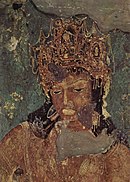Pravarasena I
This article has multiple issues. Please help improve it or discuss these issues on the talk page. (Learn how and when to remove these template messages)
|
| Pravarasena I | |
|---|---|
| Samrāṭ | |
| Reign | c. 275 – 335 CE |
| Predecessor | Vindhyashakti |
| Successor | |
| Issue |
|
Vakataka | |
| Vakataka dynasty c. 250 - 510 CE | ||||||||||||||||
|---|---|---|---|---|---|---|---|---|---|---|---|---|---|---|---|---|
|
||||||||||||||||
| Nandivardhana-Pravarapura Branch | ||||||||||||||||
|
||||||||||||||||
| Vatsagulma Branch | ||||||||||||||||
|
||||||||||||||||
Pravarasena (r. c. 275 – 335 CE
Reign
No inscription or record from Pravarasena's reign has been discovered.[2] Information on his reign and accomplishments is dependent on later records of the Vakataka dynasty as well as from the Puranic literary tradition. The Puranas are unanimous in giving Pravarasena (or "Pravira", as he is called in the Puranic texts) a long reign of 60 years. That Pravarasena lived to old age seems to be supported by the fact that Pravarasena's grandson was among the successors to his empire.[4]
Although the details of Pravarasena's military campaigns are unknown, their number and significance can be gauged from the many Vedic sacrifices that he is said to have performed. Pravarasena performed no less than four ashvamedha horse sacrifices during his reign, and each one may have marked the termination of a successful campaign.[5] As an orthodox Hindu and champion of the Brahmanical religious tradition, Pravarasena also performed many other Vedic sacrifices including the Agnishṭoma, Āptoryāma, Jyotishṭoma, Bṛihaspatisava, Sādyaskra, Ukthya, Shoḍaśin, and Atirātra sacrifices.[2] At the end of his career, after he had achieved overlordship over the Deccan, Pravarasena celebrated the Vājapeya sacrifice and formally assumed the imperial title of Samrāṭ.[6]
To the north of Pravarasena's empire were the powerful Bharashiva Naga kings, who were a strong force in the central regions of India. Pravarasena forged an important political alliance with King Bhavanaga of the Bharashiva dynasty by marrying his son Gautamiputra to Bhavanaga's daughter.[3] This alliance secured the northern border of the Vakataka dominions and left Pravarasena free to expand into the south. It is also possible that Pravarasena performed his multiple ashvamedha sacrifices in imitation of the Bharashiva Nagas, for the latter are said to have performed no fewer than ten ashvamedha sacrifices.[2]
Pravarasena's capital was called Kanchanaka and has been identified with Nachna in the
Legacy
Pravarasena's eldest son was Prince Gautamiputra, but he predeceased his father. Gautamiputra's son
All of the
References
- ISBN 9788120800434.
- ^ a b c d D.C. Sircar (1968). Majumdar, R.C. (ed.). The Age of Imperial Unity (Fourth ed.). Bharatiya Vidya Bhavan. p. 220.
- ^ ISBN 9788131716779.
- ^ A.S. Altekar (1960). Yazdani, Ghulam (ed.). The Early History of the Deccan. Oxford University Press. p. 158.
- ^ Altekar (2007), p.91
- ^ Altekar (1960), p. 162
- ^ Altekar (1960), p. 161
- ^ Altekar (2007), p. 94
- ^ Altekar (1960), pp. 163–164
- ^ Singh (2016), p. 484
- ISBN 81-219-0887-6, p. 588
- ^ Altekar (1960), pp. 156–157


